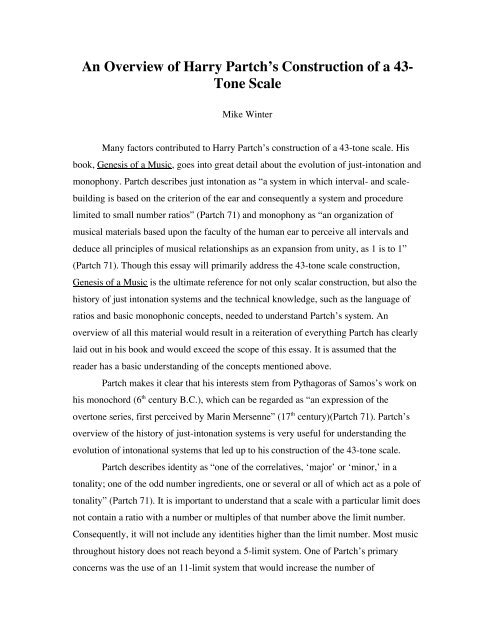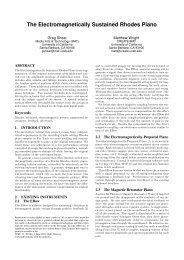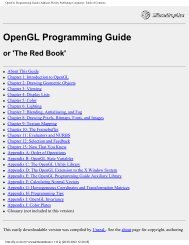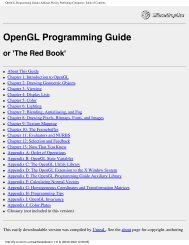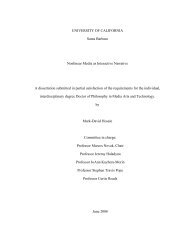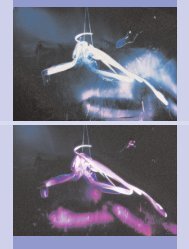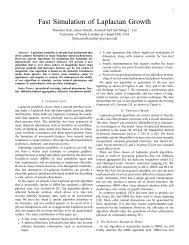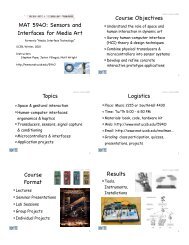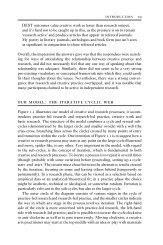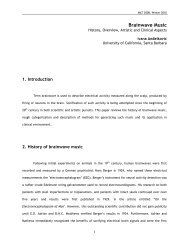An Overview of Harry Partch's Construction of a 43- Tone Scale
An Overview of Harry Partch's Construction of a 43- Tone Scale
An Overview of Harry Partch's Construction of a 43- Tone Scale
Create successful ePaper yourself
Turn your PDF publications into a flip-book with our unique Google optimized e-Paper software.
<strong>An</strong> <strong>Overview</strong> <strong>of</strong> <strong>Harry</strong> Partch’s <strong>Construction</strong> <strong>of</strong> a <strong>43</strong>-<br />
<strong>Tone</strong> <strong>Scale</strong><br />
Mike Winter<br />
Many factors contributed to <strong>Harry</strong> Partch’s construction <strong>of</strong> a <strong>43</strong>-tone scale. His<br />
book, Genesis <strong>of</strong> a Music, goes into great detail about the evolution <strong>of</strong> just-intonation and<br />
monophony. Partch describes just intonation as “a system in which interval- and scale-<br />
building is based on the criterion <strong>of</strong> the ear and consequently a system and procedure<br />
limited to small number ratios” (Partch 71) and monophony as “an organization <strong>of</strong><br />
musical materials based upon the faculty <strong>of</strong> the human ear to perceive all intervals and<br />
deduce all principles <strong>of</strong> musical relationships as an expansion from unity, as 1 is to 1”<br />
(Partch 71). Though this essay will primarily address the <strong>43</strong>-tone scale construction,<br />
Genesis <strong>of</strong> a Music is the ultimate reference for not only scalar construction, but also the<br />
history <strong>of</strong> just intonation systems and the technical knowledge, such as the language <strong>of</strong><br />
ratios and basic monophonic concepts, needed to understand Partch’s system. <strong>An</strong><br />
overview <strong>of</strong> all this material would result in a reiteration <strong>of</strong> everything Partch has clearly<br />
laid out in his book and would exceed the scope <strong>of</strong> this essay. It is assumed that the<br />
reader has a basic understanding <strong>of</strong> the concepts mentioned above.<br />
Partch makes it clear that his interests stem from Pythagoras <strong>of</strong> Samos’s work on<br />
his monochord (6 th century B.C.), which can be regarded as “an expression <strong>of</strong> the<br />
overtone series, first perceived by Marin Mersenne” (17 th century)(Partch 71). Partch’s<br />
overview <strong>of</strong> the history <strong>of</strong> just-intonation systems is very useful for understanding the<br />
evolution <strong>of</strong> intonational systems that led up to his construction <strong>of</strong> the <strong>43</strong>-tone scale.<br />
Partch describes identity as “one <strong>of</strong> the correlatives, ‘major’ or ‘minor,’ in a<br />
tonality; one <strong>of</strong> the odd number ingredients, one or several or all <strong>of</strong> which act as a pole <strong>of</strong><br />
tonality” (Partch 71). It is important to understand that a scale with a particular limit does<br />
not contain a ratio with a number or multiples <strong>of</strong> that number above the limit number.<br />
Consequently, it will not include any identities higher than the limit number. Most music<br />
throughout history does not reach beyond a 5-limit system. One <strong>of</strong> Partch’s primary<br />
concerns was the use <strong>of</strong> an 11-limit system that would increase the number <strong>of</strong>
combinations possible for both otonality or utonality’s identities. This produces a<br />
multitude <strong>of</strong> triads, tetrads, and pentads. <strong>An</strong> otonality is “a tonality expressed by the over<br />
numbers <strong>of</strong> ratios having a numerary nexus” (Partch 72), which is “the common number<br />
to all identities in the ratios <strong>of</strong> one tonality” (Partch 72). A utonality is a tonality<br />
“expressed by the under numbers <strong>of</strong> ratios having a numerary nexus” (Partch 75). The 5-<br />
limit system only contains one triad from the combination <strong>of</strong> the 1-3-5 identities and has<br />
few secondary tonalities, most <strong>of</strong> which are not complete through the five identities.<br />
<strong>An</strong> 11-limit system would create 20 triads, 15 tetrads, and 6 pentads. In Genesis<br />
<strong>of</strong> a Music, Partch shows all <strong>of</strong> these on pages 123 – 124, but they can be calculated by<br />
exhausting all combinations <strong>of</strong> the numbers 1, 3, 5, 7, 9, and 11. Also, there would be 16<br />
secondary tonalities; two <strong>of</strong> which are complete through their 11 identities, four <strong>of</strong> which<br />
are complete through their 9 identities, six <strong>of</strong> which have the 9 identities with the seven<br />
missing, and four <strong>of</strong> which are complete through their 5 identities (Partch 161).<br />
<strong>An</strong> overview <strong>of</strong> these possibilities simply illustrates reasons why Partch had<br />
interest in using an 11-limit system. In fact, his use <strong>of</strong> an 11-limit system as opposed to a<br />
13 or higher-limit system is quite arbitrary. He states, “From a scale standpoint this (i.e.<br />
the use <strong>of</strong> a 13-limit system) is not objectionable, and from a harmonic standpoint it is far<br />
from objectionable… The reason for resting at the limit <strong>of</strong> 11 is a purely personal and<br />
arbitrary one” (Partch 123). Now, with an understanding <strong>of</strong> both the arbitrary reason and<br />
the harmonic reasons <strong>of</strong> using an 11-limit system, we can move on to the details <strong>of</strong> how<br />
Partch arrived at a <strong>43</strong>-tone scale.<br />
The initial step is to calculate all non-multiple-number ratios <strong>of</strong> the 11-limit. To<br />
achieve this, one must understand three parameters for the calculations.<br />
1) All ratios must contain a 1, 3, 5, 7, 9, or 11, which are all identities <strong>of</strong> the 11-<br />
limit.<br />
2) A ratio cannot contain an identity beyond the 11-limit, which is represented<br />
by any odd number above 11.<br />
3) All ratios should be less than 2/1.<br />
From smallest to largest these are ordered 1/1, 12/11, 11/10, 10/9, 8/7, 7/6, 6/5, 11/9, 5/4,<br />
14/11, 9/7, 4/3, 11/8, 7/5, 10/7, 16/11, 3/2, 14/9, 11/7, 8/5, 18/11, 5/3, 12/7, 7/4, 16/9, 9/5,<br />
20/11, 11/6, (2/1). On page 127 <strong>of</strong> Genesis <strong>of</strong> a Music, Partch lists all these ratios with a
cent deviation from the 1/1 and the ratios and cent deviations that represent all intervals<br />
in between. To calculate the ratio <strong>of</strong> the interval between any <strong>of</strong> the above ratios, one can<br />
multiply the larger ratio by the reciprocal <strong>of</strong> the smaller ratio. For example, the ratio for<br />
the interval between 12/11 and 11/10 can be calculated from 12/11 * 10/11 = 121/120. To<br />
illustrate the perceived distance <strong>of</strong> any given interval, one can calculate the cents by this<br />
equation; (1200 /(log 2)) * (log (frequency ratio)) = distance in cents. For example, the<br />
cent deviation <strong>of</strong> 121/120 = (1200 /(log 2)) * (log (121/120)) = approx. 14.4 cents. The<br />
scale one arrives at happens to be completely symmetrical and Partch proclaims, “The<br />
inevitable symmetry <strong>of</strong> the structure is apparent (Partch 135).”<br />
When calculating the intervals between all <strong>of</strong> the ratios listed above, it becomes<br />
evident that there are wide gaps between some intervals. The intervals between the 1/1<br />
and 12/11, and the 11/6 and 2/1 are the widest in the set. There are also gaps between the<br />
7/6 and 6/5, the 9/7 and 4/3, the 4/3 and 11/8, the 16/11 and 3/2, the 3/2 and 14/9, and the<br />
5/3 and 12/7 (Partch 131 – 132).<br />
Though one could simply leave the gaps, Partch felt that a scalar construction<br />
should not have gaps and that the overall distribution should be somewhat uniform.<br />
Partch carefully fills the spaces listed above by implanting multiple-number ratios<br />
between these intervals. The use <strong>of</strong> multiple-number ratios “contribute(s) to further<br />
increase <strong>of</strong> new tonalities” (Partch 129). To determine the multiple-number ratios<br />
between an interval, one can multiply any <strong>of</strong> the identities <strong>of</strong> the limit and use the<br />
numerator or denominator to create an interval that lays in the space that one desires to<br />
fill. For example, to find a multiple-number ratio between the 1/1 and 12/11, one can take<br />
the 3 rd multiple <strong>of</strong> the 5 th identity, or vise-versa, which equals 15. If fifteen is the<br />
numerator, the only denominator in the 11-limit that would create a ratio within this<br />
space is 14, which gives a ratio <strong>of</strong> 15/14. If 15 is the denominator, then the only<br />
numerator that would function for our purpose is 16, making a ratio <strong>of</strong> 16/15. General<br />
principles that one can use to determine these pitches include:<br />
1) No ratio can include a multiple <strong>of</strong> a prime number higher than 11.<br />
2) <strong>An</strong>y multiple-number ratio will not contain a number below any <strong>of</strong> the<br />
numbers in the ratios bounding the space that one desires to fill.
3) The complement <strong>of</strong> a ratio that fills a gap on one side <strong>of</strong> the center axis <strong>of</strong> a<br />
scale will fill the complementary gap on the other side <strong>of</strong> the axis.<br />
The third principle simply suggests that after determining how one might fill the spaces<br />
on one side <strong>of</strong> a scale’s symmetrical axis, the complements <strong>of</strong> the determined ratios will<br />
fill the gaps on the other side <strong>of</strong> the symmetrical axis. If the numerator is even, the<br />
complement is the reciprocal ratio with the even number divided by 2. If the denominator<br />
is even, the complement is the reciprocal <strong>of</strong> the ratio with the even number multiplied by<br />
2. For instance, the complement <strong>of</strong> 16/15 is 15/8, and the complement <strong>of</strong> 81/80 is 160/81.<br />
This maintains the symmetry <strong>of</strong> the scale because the interval between 1/1 and 16/15 is<br />
the same perceived distance as the interval between 15/8 and 2/1. Conversely, the<br />
perceived distance between 16/15 and 12/11 is the same as 11/6 and 15/8. Partch gives<br />
many <strong>of</strong> the possibilities <strong>of</strong> multiple-number ratios on page 131 <strong>of</strong> Genesis <strong>of</strong> a Music.<br />
Because there are many multiple-number ratio possibilities, Partch explains that<br />
when subdividing intervals, “successive-number ratios are appropriated simply because<br />
they are the ratios <strong>of</strong> the smallest numbers available for the purpose (Partch 129).” For<br />
example, when the interval between the 7/6 and the 6/5 is divided by the 32/27, the<br />
intervals created between the 7/6 and 32/27 and the 32/27 and 6/5 are 64/63 and 81/80,<br />
respectively. He also suggests that “gaps should contain degrees spaced approximately as<br />
they are spaced in the sequence <strong>of</strong> the twenty-nine ratios shown previously, in which the<br />
smallest interval between degrees is 14.4 cent and the largest exactly 63 cents”<br />
(Partch131).<br />
Partch suggests creating a feel <strong>of</strong> perpetual tonal ascent or descent as another<br />
factor in determining how to subdivide larger intervals that need multiple subdivisions<br />
like the gaps between the 1/1 and 12/11 and the 11/6 and 2/1. A tonal descent is achieved<br />
by successive-number ratios that get smaller (expressed with larger numbers) as they<br />
approach 1/1 and a tonal ascent is achieved by the complements <strong>of</strong> successive-number<br />
ratios that get smaller as they approach 2/1(Partch 129-131).<br />
When subdividing a gap, Partch chooses multiple-number ratios and their<br />
complements. This creates important identities in secondary tonalities, intervals with<br />
successive-multiple-number ratios, uniformly spaces the scale, and leads to tonal ascents<br />
and descents. To divide the gap between 1/1 and 12/11, he uses the intervals <strong>of</strong> 81/80,
33/32, 21/20, and 16/15. The compliments, 160/81, 64/63, 40/21, 15/8, respectively,<br />
divide the gap between the 11/6 and 2/1. He divides the intervals between the 7/6 and 6/5,<br />
the 9/7 and 4/3, the 4/3 and 11/8 with 32/27, 21/16, and 27/20, respectively. The<br />
complements <strong>of</strong> these last three ratios, 27/16, 32/21, and 40/27, respectively, divide the<br />
gaps between the 5/3 and 12/7, the 3/2 and 14/9, and the 16/11 and 3/2, respectively.<br />
These divisions are laid out on pages 131 and 132 <strong>of</strong> Genesis <strong>of</strong> a Music. Though he<br />
could have used other options, it is evident that he deliberated very hard and exhausted<br />
many possibilities before arriving at his final <strong>43</strong>-tone scale.<br />
By examining the above calculations, we have followed Partch’s path to this <strong>43</strong>-<br />
tone scale represented by the following list <strong>of</strong> frequency ratios:<br />
1/1, 81/80, 33/32, 21/20, 16/15, 12/11, 11/10, 10/9, 9/8, 8/7, 7/6, 32/27, 6/5, 11/9,<br />
5/4, 14/11, 9/7, 21/16, 4/3, 27/20, 11/8, 7/5, 10/7, 16/11, 40/27, 3/2, 32/21, 14/9,<br />
11/7, 8/5, 18/11, 5/3, 27/16, 12/7, 7/4, 16/9, 9/5, 20/11, 11/6, 15/8, 40/21, 64/33,<br />
160/81, and (2/1).<br />
Partch has documented the scale with the intervals produced between each tone and the<br />
subsequent cent deviations on page 133.<br />
Now, with an understanding <strong>of</strong> how Partch calculated his <strong>43</strong>-tone scale, one may<br />
better see the multitude <strong>of</strong> possibilities it creates. In Genesis <strong>of</strong> a Music, Partch states,<br />
“The major contribution <strong>of</strong> Monophony as an intonational system is its realization <strong>of</strong> a<br />
subtle and acoustically precise interrelation <strong>of</strong> tonalities, all stemming or expanding from<br />
unity, 1/1. This interrelation is not capable <strong>of</strong> manifold modulations to ‘dominants’ or to<br />
any <strong>of</strong> the other common scale degrees; it is not capable <strong>of</strong> parallel transpositions <strong>of</strong><br />
intricate musical structures; it does not present any tone as any specific tonality identity.<br />
Conversely, it is capable <strong>of</strong> both ordinary and hitherto unheard modulations to the natural<br />
limits imposed by Just Intonation and the arbitrary limit <strong>of</strong> 11; it is capable <strong>of</strong> an<br />
expanded sense <strong>of</strong> tonality, from Identities 1-3-5 to Identities 1-3-5-7-9-11; it is capable<br />
<strong>of</strong> great variety in that expanded sense; it does <strong>of</strong>fer twenty-eight possible tonalities,<br />
more than are inherent in Equal Temperament, and therefore a greater total <strong>of</strong> tonality<br />
identities, or assumable senses, than does Equal Temperament” (Partch 158).<br />
Although, Partch’s system does not present a “cycle” because “no multiple <strong>of</strong> an<br />
interval will go into another interval” (Partch 135), a composer still has a plethora <strong>of</strong>
tonal possibilities. It is helpful to understand that most music, especially tonal, is<br />
reflective <strong>of</strong> the natural harmonic series. When a scale is tempered, we abstract ourselves<br />
from that particular natural phenomenon. No doubt, a vast array <strong>of</strong> repertoire has<br />
exploited the benefits <strong>of</strong> Equal Temperament in a successful and positive way, but it is<br />
the natural process <strong>of</strong> musical evolution to explore different musical possibilities. The<br />
quantization <strong>of</strong> an infinite amount <strong>of</strong> pitch possibilities to a series <strong>of</strong> 12 pitches can be<br />
quite limiting. Therefore, it appears natural that a composer would seek an alternative.<br />
Partch’s system is closely connected to theories that have been in existence for thousands<br />
<strong>of</strong> years, but it is the rejection <strong>of</strong> musical theories shortly prior to his time and a strong<br />
sense for a particular type <strong>of</strong> natural harmony that inspired his work. Presumably, there<br />
will be continued developments in intonational systems for as long as music is being<br />
created. It is the responsibility <strong>of</strong> musicians to attempt to learn the principles <strong>of</strong> many<br />
different methodologies, instead <strong>of</strong> only one system. Then, other intonational systems can<br />
be exploited to the extent <strong>of</strong> 12-tone Equal Temperament.<br />
Bibliography:<br />
Partch, <strong>Harry</strong>. Genesis <strong>of</strong> a Music. New York: Da Capo Press, 1974.


